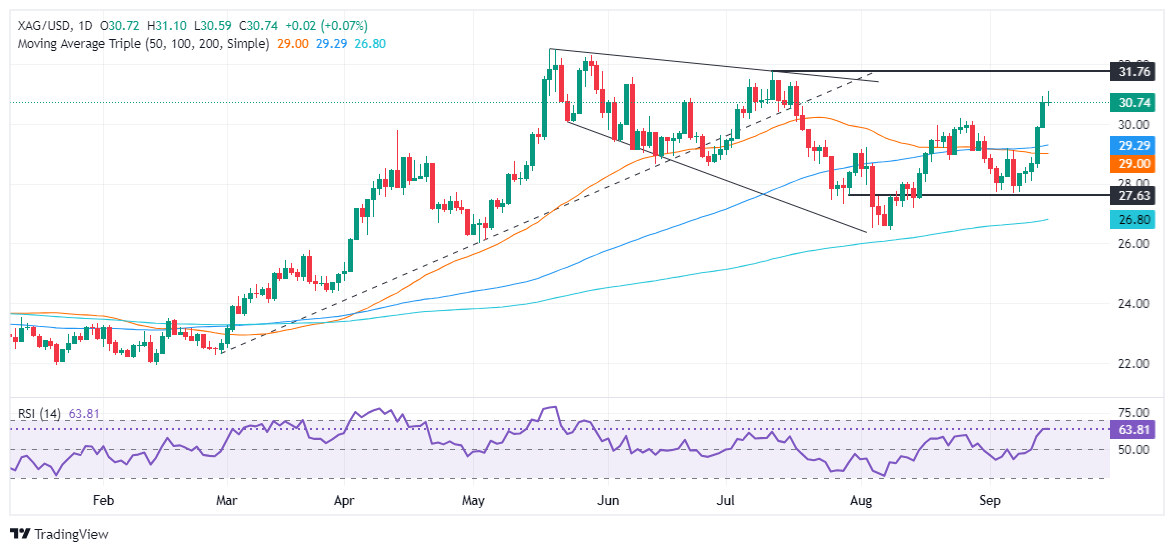Silver Price Forecast: XAG/USD extends winning streak, hovers around $31.00
- Silver’s uptrend continues, as solid resistance emerges at $30.70-$30.90.
- A break above $31.00 could lead to further gains, targeting $31.54, $31.75, and the YTD high at $32.51.
- Sellers must push prices below $29.86 for a bearish shift and challenge lower support levels.
Silver prices edged up modestly late on Monday, bolstered by a weaker US Dollar and a drop in US Treasury yields. Speculation that the Federal Reserve would cut rates by 50 basis points (bps) weighed on the buck and yields. The XAG/USD trades at $30.75, extending its winning streak to six days.
XAG/USD Price Forecast: Technical outlook
Silver’s uptrend remains intact after six days of continuing gains, though the grey metal faces strong resistance at a downslope resistance trendline drawn from May-July highs that pass at around $30.70-$30.90.
Momentum favors buyers, as the Relative Strength Index (RSI) shows. However, it has begun to turn flat, hinting that consolidation lies ahead.
XAG/USD must clear the $31.00 figure for a bullish continuation. A decisive break would expose the June 7 high at $31.54, followed by the July 11 peak at $31.75. On additional strength, the next stop would be the $32.00 figure, ahead of the year-to-date (YTD) high at $32.51.
Conversely, sellers must bring prices below the September 13 low of $29.86 to challenge lower prices.
XAG/USD Price Action – Daily Chart

Silver FAQs
Silver is a precious metal highly traded among investors. It has been historically used as a store of value and a medium of exchange. Although less popular than Gold, traders may turn to Silver to diversify their investment portfolio, for its intrinsic value or as a potential hedge during high-inflation periods. Investors can buy physical Silver, in coins or in bars, or trade it through vehicles such as Exchange Traded Funds, which track its price on international markets.
Silver prices can move due to a wide range of factors. Geopolitical instability or fears of a deep recession can make Silver price escalate due to its safe-haven status, although to a lesser extent than Gold's. As a yieldless asset, Silver tends to rise with lower interest rates. Its moves also depend on how the US Dollar (USD) behaves as the asset is priced in dollars (XAG/USD). A strong Dollar tends to keep the price of Silver at bay, whereas a weaker Dollar is likely to propel prices up. Other factors such as investment demand, mining supply – Silver is much more abundant than Gold – and recycling rates can also affect prices.
Silver is widely used in industry, particularly in sectors such as electronics or solar energy, as it has one of the highest electric conductivity of all metals – more than Copper and Gold. A surge in demand can increase prices, while a decline tends to lower them. Dynamics in the US, Chinese and Indian economies can also contribute to price swings: for the US and particularly China, their big industrial sectors use Silver in various processes; in India, consumers’ demand for the precious metal for jewellery also plays a key role in setting prices.
Silver prices tend to follow Gold's moves. When Gold prices rise, Silver typically follows suit, as their status as safe-haven assets is similar. The Gold/Silver ratio, which shows the number of ounces of Silver needed to equal the value of one ounce of Gold, may help to determine the relative valuation between both metals. Some investors may consider a high ratio as an indicator that Silver is undervalued, or Gold is overvalued. On the contrary, a low ratio might suggest that Gold is undervalued relative to Silver.

